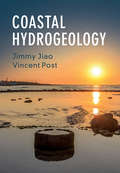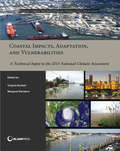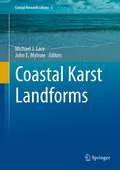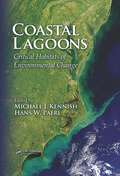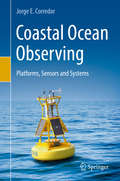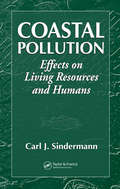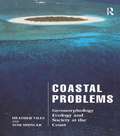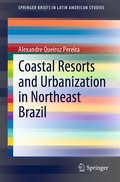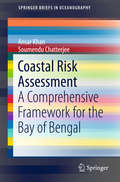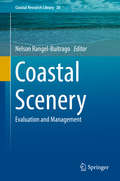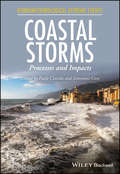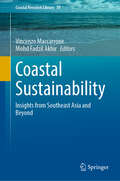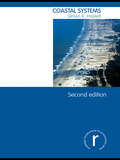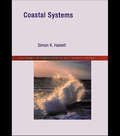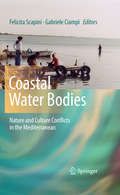- Table View
- List View
Coastal Hydrogeology
by Jimmy Jiao Vincent PostWater resources are of enormous societal and ecological importance. In coastal areas, they are under ever greater pressure due to population growth, more affluent lifestyles, food production and the growing tourism industry. Changes to the coastal landscape, through urbanisation and land reclamation, and by natural processes such as climate change and sea level rise, modify the interaction between seawater and groundwater and put water resources at risk. This comprehensive volume covers both theory and practice of coastal hydrogeology. It discusses hydrochemistry; submarine groundwater discharge; groundwater management; palaeo-hydrology; land reclamation; climate change and sea level rise; and mathematical models of variable-density flow. With its up-to-date coverage and numerous case studies that illustrate practical implications, it is perfect for students, practitioners, managers and researchers who wish to develop an in-depth understanding of topics relevant to sustainably managing coastal groundwater resources.
Coastal Impacts, Adaptation, and Vulnerabilities: A Technical Input to the 2013 National Climate Assessment (NCA Regional Input Reports)
by Margaret Davidson Virginia BurkettDeveloped to inform the 2013 National Climate Assessment, and a landmark study in terms of its breadth and depth of coverage and conducted under the auspices of the U. S. Global Change Research Program, Coastal Impacts, Adaptation, and Vulnerabilities examines the known effects and relationships of climate change variables on the coasts of the U. S. This state of the art assessment comes from a broad range of experts in academia, private industry, state and local governments, NGOs, professional societies, and impacted communities. It includes case studies on topics such as adaptive capacity; climate change effects on. It highlights past climate trends, projected climate change and vulnerabilities, and impacts to specific sectors. Rich in science and case studies, it examines the latest climate change impacts, scenarios, vulnerabilities, and adaptive capacity for nine major coastal regions of the United States and provides essential guidance for decision-makers - as well as environmental academics, professionals, and advocates - who seek to better understand how climate variability and change impact the US coasts and its communities.
Coastal Karst Landforms (Coastal Research Library #5)
by John E. Mylroie Michael J. LaceCarbonate rock coasts are found world-wide, from continental shorelines of the Adriatic Sea of Europe to the Yucatan Peninsula of North America, and on tropical islands from Rodrigues Island in the Indian Ocean, to the Mariana Islands in the Pacific Ocean, to the Bahama Islands in the Atlantic Ocean. Such coasts are well known for their unusual and distinctive karst landforms. Karst processes, particularly those associated with coastal landforms, are proving to be surprisingly unique and complex. This volume presents a comprehensive overview of the processes associated with coastal karst development comparing examples from a broad geographical and geomorphological range of island and continental shoreline/paleoshoreline settings, including a review of pseudokarst processes that can compete with and overprint dynamic coastal karst landscapes. As effective management of hydrologic resources grows more complex, coastal caves and karst represent fundamental components in associated coastal aquifers, which in the rock record can also form significant petroleum reservoirs. Audience By providing a clearer understanding of the geological, biological, archaeological and cultural value of coastal caves and karst resources, this volume offers a critical tool to coastal researchers and geoscientists in related fields and to coastal land managers as it illustrates the diversity of coastal karst landforms, the unique processes which formed them, the diversity of resources they harbor and their relationship to coastal zone preservation strategies and the development of sustainable management approaches.
Coastal Lagoons: Critical Habitats of Environmental Change (ISSN)
by Michael J. Kennish Hans W. PaerlWritten by an outstanding group of contributors, this book examines the function and structure of coastal lagoonal ecosystems and the natural and anthropogenic drivers of change that affect them, most notably nutrient over-enrichment from coastal watersheds and airsheds. The contributors target the susceptibility of coastal lagoons to eutrophication, the indicators of eutrophic conditions, the influences of natural factors such as major storms and other climate effects, and the resulting biotic and ecosystem impairments that have developed. The book compares biogeochemical and ecological response to nutrient enrichment and other pollutants in lagoonal estuaries to those in other estuarine types.
Coastal Ocean Observing: Platforms, Sensors and Systems
by Jorge E. CorredorThis manual describes the wide range of electromechanical, electrochemical and electro-optical transducers at the heart of current field-deployable ocean observing instruments. Their modes of operation, precision and accuracy are discussed in detail. Observing platforms ranging from the traditional to the most recently developed are described, as are the challenges of integrating instrument suits to individual platforms. Technical approaches are discussed to address environmental constraints on instrument and platform operation such as power sources, corrosion, biofouling and mechanical abrasion. Particular attention is also given to data generated by the networks of observing platforms that are typically integrated into value-added data visualization products, including numerical simulations or models. Readers will learn about acceptable data formats and representative model products. The last section of the book is devoted to the challenges of planning, deploying and maintaining coastal ocean observing systems. Readers will discover practical applications of ocean observations in diverse fields including natural resource conservation, commerce and recreation, safety and security, and climate change resiliency and adaptation. This volume will appeal to ocean engineers, oceanographers, commercial and recreational ocean data users, observing systems operators, and advanced undergraduate and graduate students in the field of ocean observing.
Coastal Pollution: Effects on Living Resources and Humans
by Carl J. SindermannIn 1996, after more than a decade of researching the effects of over-population and the consequent pollution of the greater metropolitan New York City area, Carl Sindermann published his observations and conclusions in Ocean Pollution: Effects on Living Resources and Humans, a mostly technical document that emphasized the pathological effects of co
Coastal Problems: Geomorphology, Ecology and Society at the Coast
by Heather Viles Tom SpencerAs coastal populations burgeon, problems of erosion, pollution and coastal change are becoming ever more serious and necessitate scientifically informed management strategies. This authoritative new study discusses the causes of, and possible solutions to, some of the more pressing problems at the coast, against a background of the natural geomorphological and ecological workings of coastal environments.A holistic approach to the understanding of coastal problems is suggested, which integrates geomorphology, ecology and society through a consideration of the basic processes at work. Coastal problems are caused by both human and natural impacts, often working in conjunction with each other; thus drawing on their wide experience of temperate and tropical coasts the authors consider all types of coastal problems, ranging from those produced entirely naturally to those where the human impact dominates. Extensive use is made of case studies drawn from around the world, from beach erosion along the Nigerian coast to the recovery of the Vietnamese mangroves from war damage. A major theme of the book is that, given recent downgrading of predictions of future sea level rise, it is the distinctive geomorphological, ecological and societal aspects of each coast which are the vital factors.'Coastal Problems' brings together material vital to any attempts to understand and manage our coasts and will be of interest to all those concerned with the environment and its management.
Coastal Resorts and Urbanization in Northeast Brazil (SpringerBriefs in Latin American Studies)
by Alexandre Queiroz PereiraThis book intends to present the development of socio-spatial practices in the metropolitan coast of the Northeast of Brazil, highlighting the main urban, spa and tourist agglomerations: Salvador-BA, Recife-PE, Fortaleza-CE, and Natal-RN. The objective is to study the processes of urbanization associated with maritime leisure. In the first chapter, the reader will find a historical and conceptual presentation highlighting the relevance of leisure practices, their forms-flows and their role in the formation of maritime resorts. The second chapter analyses the context of the northeastern region of Brazil and demonstrates the process of modernization and formation of the seaside function within the cities, and later, in the maritime metropolises of the region. The relationship between urbanization and touristic real estate ventures is the central theme of the third chapter, which proposes a specific methodology for studies of this nature. The final chapter presents the seaside resorts in the metropolitan area of Fortaleza, a case study similar to others in the Northeast, examining the urbanistic effects and the key ideas of the planners.
Coastal Risk Assessment: A Comprehensive Framework For The Bay Of Bengal (Springerbriefs In Oceanography Ser.)
by Soumendu Chatterjee Ansar KhanThis book discusses how to collect data and analyze databases in order to map risk zones, and contributes to developing a conceptual framework for coastal risk assessment. Further, the book primarily focuses on a specific case study: the Bay of Bengal along the southeastern coast of India. The dramatic rise in losses and casualties due to natural disasters like wind, storm-surge-induced flooding, seismic hazards and tsunami incidence along this coast over the past few decades has prompted a major national scientific initiative investigating the probable causes and possible mitigation strategies. As such, geoscientists are called upon to analyze the coastal hazards by anticipating the changes in and impacts of extreme weather hazards on the Bay of Bengal coasts as a result of global climate change and local sea-level change.
Coastal Scenery: Evaluation And Management (Coastal Research Library #26)
by Nelson Rangel-BuitragoThis book describes an easy to apply methodology to determine the scenic value of a coast. As one of the most critical aspects of beach user choice, the determination of coastal area scenic quality is of primordial importance. This book is, therefore, an extremely useful tool for any coastal lovers, being them users, teachers, researchers, or managers.In particular, this work is the first book to present a semi-quantitative analysis of coastal scenery based on more than 4,000 interviews about people’s desired coastal imaginary. Twenty-six parameters can be used to identify any coastal scene, which have then been sub-divided into five attribute categories, weighted and subjected to fuzzy logic mathematics to obtain a decision number (D). This number D represents the coastal scenery at that point, and Five D classes are then presented (from I-excellent, to V-poor). Heritage areas, like National Parks should lie in Class I, which infers top scenic quality.Over a time span of a decade or so, the authors of this book have assessed more than 900 global locations using the technique given in this book. One of the main aims of this method is to point out how scenic areas may be improved by judicious intervention relating to parameters, mainly anthropogenic, chosen for assessment.The content of this book opens perspectives for analysis of the potential for coastal tourism development in natural areas and for landscape quality improvement in current coastal tourist developed areas. “In a very comprehensive way, this book reviews the main concepts about coastal scenery and through the vast global work experience of the authors, presents different methodologies, as well as introducing a novel methodology, using parameter weightings and fuzzy logic mathematics.”Carlos Pereira da Silva, CICS.NOVA, Universidade Nova de Lisboa, Lisbon, Portugal “Our lives will be greatly enriched by finding beauty, but we can use help in defining the many ways beauty can be manifested. This book can help us by informing us of the ways landscapes can be viewed and described from many viewpoints to place our own understanding in better perspective.”Karl Nordstrom, Geography Department, Rutgers University, New Jersey, USA “How do we define and quantify a coast’s scenic value? This is the book. It begins by defining coastal scenery, then reviews the approaches to quantifying it, followed by a new fuzzy logic approach and examples. It finishes with a chapter on how to manage these attractive landscapes, many of which are being overrun and ruined by development. This is a must read for researchers who wish to evaluate and managers who wish to maintain this valuable yet intangible coastal resource.”Andrew Short, Coastal Studies Unit, Sydney University, Australia
Coastal Storms: Processes and Impacts (Hydrometeorological Extreme Events)
by Paolo Ciavola Oscar FerreiraA comprehensive introduction to coastal storms and their associated impacts Coastal Storms offers students and professionals in the field a comprehensive overview and groundbreaking text that is specifically devoted to the analysis of coastal storms. Based on the most recent knowledge and contributions from leading researchers, the text examines coastal storms’ processes and characteristics, the main hazards (such as overwash, inundation and flooding, erosion, structures overtopping), and how to monitor and model storms. The authors include information on the most advanced innovations in forecasting, prediction, and early warning, which serves as a foundation for accurate risk evaluation and developing adequate coastal indicators and management options. In addition, structural overtopping and damage are explained, taking into account the involved hydrodynamic and morphodynamic processes. The monitoring methods of coastal storms are analyzed based on recent results from research projects in Europe and the United States. Methods for vulnerability and risk evaluation are detailed, storm impact indicators are suggested for different hazards and coastal management procedures analyzed. This important resource includes: Comprehensive coverage of storms and associated impacts, including meteorological coastal storm definitions and related potential consequences A state-of-the-art reference for advanced students, professionals and researchers in the field Chapters on monitoring methods of coastal storms, their prediction, early warning systems, and modeling of consequences Explorations of methods for vulnerability and risk evaluation and suggestions for storm impact indicators for different hazards and coastal management procedures Coastal Storms is a compilation of scientific and policy-related knowledge related to climate-related extreme events. The authors are internationally recognized experts and their work reflects the most recent science and policy advances in the field.
Coastal Sustainability: Insights from Southeast Asia and Beyond (Coastal Research Library #39)
by Vincenzo Maccarrone Mohd Fadzil AkhirThis book focusses at summarizing the main scientific elements of coastal zone management in coastal deltas and areas, but not only limited to that. Pollution, environmental impacts, coastal development, and oceanographic principles could be useful for South Asian and European students in marine and coastal science, providing a multidisciplinary vision. This comprehensive review delves into the intricate relationship between humans and the ocean. With contributions from leading scholars, it explores integrated coastal zone management in the Anthropocene era, addressing emerging ecological challenges and urbanization trends. The book emphasizes the importance of marine conservation and sustainable practices while discussing the future of integrated coastal zone management. It highlights the significance of preserving marine biodiversity and showcases the contributions of international collaborations like the "Mare" project. With a vision for a sustainable future, the book inspires readers to become advocates for positive change in our relationship with the ocean. It serves as a valuable resource for researchers, policymakers, and environmentalists, offering insights to foster a deeper appreciation and awareness of our marine ecosystems.
Coastal Systems
by Simon HaslettThe coast represents the crossroads between the oceans, land and atmosphere, and all three contribute to the physical and ecological evolution of coastlines. Coasts are dynamic systems, with identifiable inputs and outputs of energy and material. Changes to input force coasts to respond, often in dramatic ways as attested by the impacts of the Indian Ocean tsunami in 2004, the landfall of Hurricane Katrina along the Gulf Coast of the USA in 2005, and the steady rise of global warming driven sea-level. More than half the world’s human population lives at the coast, and here people often come into conflict with natural coastal processes. Research continues to unravel the relationship between coastal processes and society, so that we may better appreciate, understand, manage and live safely within this unique global environment. Coastal Systems offers a concise introduction to the processes, landforms, ecosystems and management of this important global environment. New to the second edition is a greater emphasis on the role of high-energy events, such as storms and tsunamis, which have manifested themselves with catastrophic effects in recent years. There is also a new concluding chapter, and updated guides to the ever-growing coastal literature. Each chapter is illustrated and furnished with topical case studies from around the world. Introductory chapters establish the importance of coasts, and explain how they are studied within a systems framework. Subsequent chapters explore the role of waves, tides, rivers and sea-level change in coastal evolution. Students will benefit from summary points, themed boxes, engaging discussion questions and new graded annotated guides to further reading at the end of each chapter. Additionally, a comprehensive glossary of technical terms and an extensive bibliography are provided. The book is highly illustrated with diagrams and original plates. The comprehensive balance of illustrations and academic thought provides a well balanced view between the role of coastal catastrophes and gradual processes, also examining the impact humans and society have and continue to have on the coastal environment.
Coastal Systems (Routledge Introductions to Environment: Environmental Science)
by Simon HaslettCoastal Systems offers a concise introduction to the processes, landforms, ecosystems, and management of coasts. Each chapter is illustrated and includes topical case studies from around the world such as:* Tsunami's in Papua New Guinea* cliff collapse in Southern England* the Great Barrier Reef* the Indian 'Super Cyclone' of 1999* the impact of development in the Florida Keys.Introductory chapters establish the importance of coasts and explain how they are studied within a system framework. Subsequent chapters explore the role of waves, rivers and sea level changes in coastal evolution. The final chapter reviews the human pressures and management of coastal systems.
Coastal Water Bodies: Nature and Culture Conflicts in the Mediterranean
by Felicita Scapini Gabriele CiampiAddressing the links between science and the real world with a sound scientific baseline, Coastal Water Bodies targets researchers of various disciplines whose interest lies in the integrated sustainable management of coastal water bodies. The main topic of this book is not the ecology according to its accepted meaning, but rather the 'places and people' concerned - the coastal zones of the Mediterranean that are rich in ecological value and the local people who survive thanks to these environmental resources. Integration is the joint consideration of different aspects of water uses and values, and new ways of understanding and managing conflicts around water use are needed if people are to benefit from integration. Sustainability of the ecological and socioeconomic environments requires a climate in which conflicts, if they need to exist, are properly managed in a non-destructive manner.
Coastal Waters of the World: Trends, Threats, and Strategies
by Don Hinrichsen Stephen OlsenNearly 60 percent of the world's population lives and works within 100 miles of a coast, and even those who don't are connected to the world's oceans through an intricate drainage of rivers and streams. Ultimately the whole of humankind is coastal. Coastal Waters of the World is a comprehensive reference source on the state of the world's coastal areas. It focuses on the tremendous pressures facing coastal areas and the management systems and strategies needed to cope with them. Don Hinrichsen explores the origins and implications of three related issues: the overwhelming threats to our coastal resources and seas from population and pollution; the destruction of critical resources through unsustainable economic activity; and the inability of governments to craft and implement rational coastal management plans. Introductory chapters present a concise summary of our coastal problems, including coastal habitat degradation and the fisheries crisis, along with a discussion of better management options. Three case studies of successful coastal governance focus on some of the problems and bring to life potential solutions. Following that are regional profiles that provide detailed information on the main population, resource, and management challenges facing each of the world's thirteen major coastal waters and seas. The book ends with a realistic and practical agenda for action that can be implemented immediately. Safeguarding these complex, interlinked ecosystems is humanity's most challenging management job. Coastal Waters of the World will help raise our awareness of coastal area concerns and provide a constructive contribution to the ongoing debate over how to manage these ever-changing areas, both for ourselves and for future generations. It will serve as a valuable reference tool and an up-to-date resource for policymakers, management specialists, and students interested in sustainable coastal governance.
Coastal Wetlands Restoration: Public Perception and Community Development (Routledge Focus on Environment and Sustainability)
by Hiromi YamashitaThis book examines a wide range of innovative approaches for coastal wetlands restoration and explains how we should use both academic research and practitioners’ findings to influence learning, practice, policy and social change. For conservationists, tidal flats and coastal wetlands are regarded as among the most important areas to conserve for the health of the entire oceanic environment. As the number of restoration projects all over the world increases, this book provides a unique assessment of coastal wetland restorations by examining existing community perceptions and by drawing on the knowledge and expertise of both academics and practitioners. Based on a four-year sociological study across three different cultural settings – England, Japan and Malaysia – the book investigates how citizens perceive the existing environment; how they discuss the risks and benefits of restoration projects; how perceptions change over time; and how governmental and non-governmental organisations work with the various community perceptions on the ground. By comparing and contrasting the results from these three countries, the book offers guidance for future conservation and restoration activities, with a specific view to working with local citizens to avoid conflict and obtain long-term investment. This book will be of great interest to students and scholars of coastal restoration, wetland conservation and citizen science, as well as environmental sociology and environmental management more broadly. It will also be of use to practitioners and policymakers involved in environmental restoration projects.
Coastal World Heritage Sites (Coastal Research Library #28)
by Vanda Claudino-SalesThis book presents the natural, environmental and scenic richness of the world’s coastal and marine areas classified by UNESCO as “Natural World Heritage Sites”. Representing well-preserved areas of exceptional significance to the planet and to humankind, they include a total of 49 marine sites, formed by reefs, atolls and gulfs, and 35 coastal sites in all oceans and all continents with exception of Antarctica. They are being protected and preserved from most degrading uses for future generations as an important legacy from the past. Exploring their richness, this book analyzes and explains these sites in a clear, understandable, scientific way, and is of interest to all who work in or care about the geosciences, environmental sciences and biosciences.
Coastal and Estuarine Management (Routledge Environmental Management)
by Peter FrenchThe coast cannot be left to nature to determine its fate. Wealth, property, economic interests, recreation, tourism and wildlife are all threatened. Coasts are an administrative battle ground and one of the most important and widely examined topics in environmental management.Coastal and Estuarine Management examines the issues surrounding the human use and abuse of estuarine and coastal environments. Emphasising the importance and significance of this natural resource, the uses and conflicts which occur and the results of human activity, this book explains the ways in which conservation and management policies and practices can protect this productive and diverse ecosystem.Examples and real-life case studies illustrate the effect of human intervention, both from an historic and contemporary perspective. Exposing the environmental consequences of estuarine pollution, Peter French highlights the need for management strategies to promote a sustainable development ethic for estuaries.
Coastal and Marine Environmental Education (Brazilian Marine Biodiversity)
by Natalia Pirani Ghilardi-Lopes Flavio Augusto BerchezThis book provides a broad overview of how the promotion of ocean and coastal literacy is being planned, applied and evaluated in Brazil, a country of continental dimensions with a great diversity of cultural, educational and social realities. It discusses a range of target groups, from children to adults; formal and informal strategies; and various promoting players, such as groups/institutions. Researchers representing Brazilian academic institutions and NGOs share their environmental education (EE) experiences in Brazil and describe the main concerns regarding the marine and coastal environments as well as how they are addressing these concerns in their EE projects. This book is of interest to anyone who is looking for ways of designing and implementing EE activities with a robust theoretical background in different socio-cultural scenarios.
Coastal and Marine Environments
by Yeqiao WangAuthored by world-class scientists and scholars, The Handbook of Natural Resources, Second Edition, is an excellent reference for understanding the consequences of changing natural resources to the degradation of ecological integrity and the sustainability of life. Based on the content of the bestselling and CHOICE-awarded Encyclopedia of Natural Resources, this new edition demonstrates the major challenges that the society is facing for the sustainability of all well-being on the planet Earth. The experience, evidence, methods, and models used in studying natural resources are presented in six stand-alone volumes, arranged along the main systems of land, water, and air. It reviews state-of-the-art knowledge, highlights advances made in different areas, and provides guidance for the appropriate use of remote sensing and geospatial data with field-based measurements in the study of natural resources. Volume 5, Coastal and Marine Environments, discusses marine and coastal ecosystems, their biodiversity, conservation, and integrated marine management plans. It provides fundamental information on coastal and estuarine systems and includes discussions on coastal erosion and shoreline change, natural disasters, evaporation and energy balance, fisheries and marine resource management, and more. New in this edition are discussions on sea level rise, renewable energy, coral reef restoration, fishery resource economics, and coastal remote sensing. This volume demonstrates the key processes, methods, and models used through many case studies from around the world. Written in an easy-to-reference manner, The Handbook of Natural Resources, Second Edition, as individual volumes or as a complete set, is an essential reading for anyone looking for a deeper understanding of the science and management of natural resources. Public and private libraries, educational and research institutions, scientists, scholars, and resource managers will benefit enormously from this set. Individual volumes and chapters can also be used in a wide variety of both graduate and undergraduate courses in environmental science and natural science at different levels and disciplines, such as biology, geography, earth system science, and ecology.
Coastal and Marine Geospatial Technologies (Coastal Systems and Continental Margins #13)
by D. R. GreenThis international collection of papers represents a selected and up-to-date overview of some of the main areas of research into the application of the geospatial technologies, including geographical information systems (GIS), remote sensing, digital mapping, global positioning systems (GPS), databases, Internet technology, and mobile field-data collection and mapping, to coastal and marine environments around the World. Aimed at the researcher, editor, practitioner and student, this volume seeks to expand the available literature in a rapidly expanding and evolving area, namely the coastal and marine environment. The book comes at a time when there is growing concern about global warming, climate change, and sea level rise, all of which will have an impact upon coastal areas. These geospatial technologies offer the possibility to gather unique environmental data to study the coast, to process the data into information, to visualise data and landscapes, to gather data in the field, and to involve stakeholders in coastal management amongst other things. Considerable potential now exists to raise awareness, to educate and to embrace these technologies as one way to promote greater knowledge and understanding of our marine and coastal environments.
Coastal, Harbour and Ocean Engineering: Proceedings of 26th International Conference on Hydraulics, Water Resources and Coastal Engineering (HYDRO 2021) (Lecture Notes in Civil Engineering #321)
by Vijay P. Singh P. V. Timbadiya M. C. DeoThis book comprises the proceedings of the 26th International Conference on Hydraulics, Water Resources and Coastal Engineering (HYDRO 2021) focusing on broad spectrum of emerging opportunities and challenges in the field of coastal, harbor and ocean engineering. It covers a range of topics, including, but not limited to, coastal disasters including tsunamis, cyclones and storm surges, sea level rise, coastal structures and oceanography, wave-structure interaction, etc. Presenting recent advances in the form of illustrations, tables, and text, it offers readers insights for their own research. In addition, the book addresses fundamental concepts and studies in the field of coastal, harbor and ocean engineering, making it a valuable resource for both beginners and researchers wanting to further their understanding of hydraulics, water resources and coastal engineering.
Coastal, Harbour and Ocean Engineering: Select Proceedings of HYDRO 2023 (Lecture Notes in Civil Engineering #424)
by Manish Pandey Giuseppe Oliveto G. V. Ramana N. V. UmamaheshThis book comprises proceedings of the 28th International Conference on Hydraulics, Water Resources, River and Coastal Engineering (HYDRO 2023). It focuses on emerging opportunities and challenges in the field of coastal, harbor and ocean engineering. The book covers a range of topics including, but not limited to, coastal disasters including tsunamis, cyclones and storm surges, sea level rise, coastal structures and oceanography, wave-structure interaction. The book presents these topics in the form of illustrations and tables, thereby providing the readers with an in-depth insight into the recent research. It also addresses fundamental concepts and studies in the field of coastal, harbor and ocean engineering, making it a valuable resource for both researchers and professionals working in the fields of hydraulics, water resources and coastal engineering.
Coastline Changes of the Baltic Sea from South to East: Past and Future Projection (Coastal Research Library #19)
by Hans Von Storch Jan Harff Kazimierz FurmańczykThe book discusses sea-level and coastline changes which are becoming increasingly important topics for the population living along the edge of the world's oceans and seas. These topics are of special importance where eustatic sea-level rise is superimposed by isostatic subsidence and storm induced coastal erosion. This is the case at the southern and eastern Baltic Sea coast: In the South, where glacio-isostatic subsidence enhances the effect of climate induced sea-level rise and strong storm effects cause a continuous retreat of the coast. At the eastern coast the glacio-isostatic uplift compensates eustatic sea-level rise, but storm induced waves cause permanent morphodynamic changes of the coastline. There is an increasing need for concepts for protection, for defense but also for the economic use of the different types of coastal zones. The elaboration of those management concepts can be facilitated through models that generate future projections of coastal developments in front of the modern climate change. The proposed anthology comprises results of the research project "Coastline Changes of the southern Baltic Sea - Past and future projection (CoPaF)" which was ran by a team of Estonian, German, and Polish geoscientists and coastal engineers from 2010 to 2013. As the southern and eastern Baltic serves as a natural laboratory for the investigation of coastal processes - the achievements of the project shall contribute not only to the solution of regional problems in Baltic coastal research and engineering, but, shall be regarded as a contributions to general foci of description, modelling and parameterization of coastal processes and morphodynamics.
